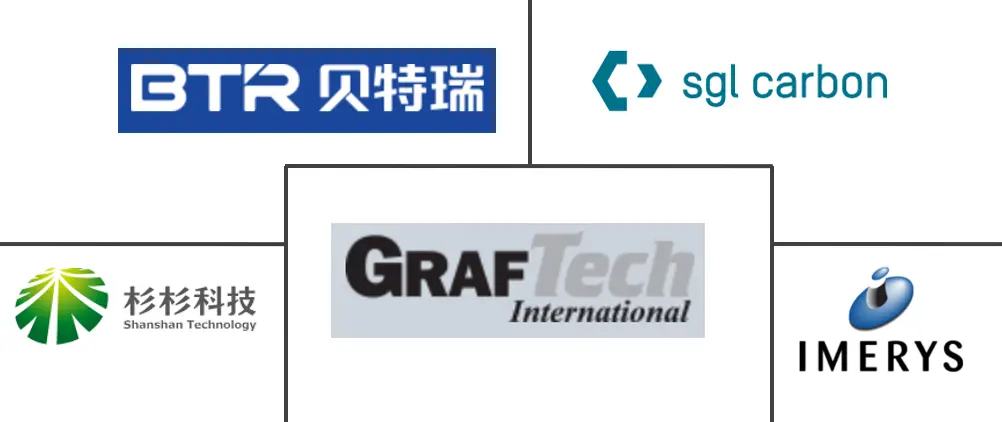Graphite Market Size and Share
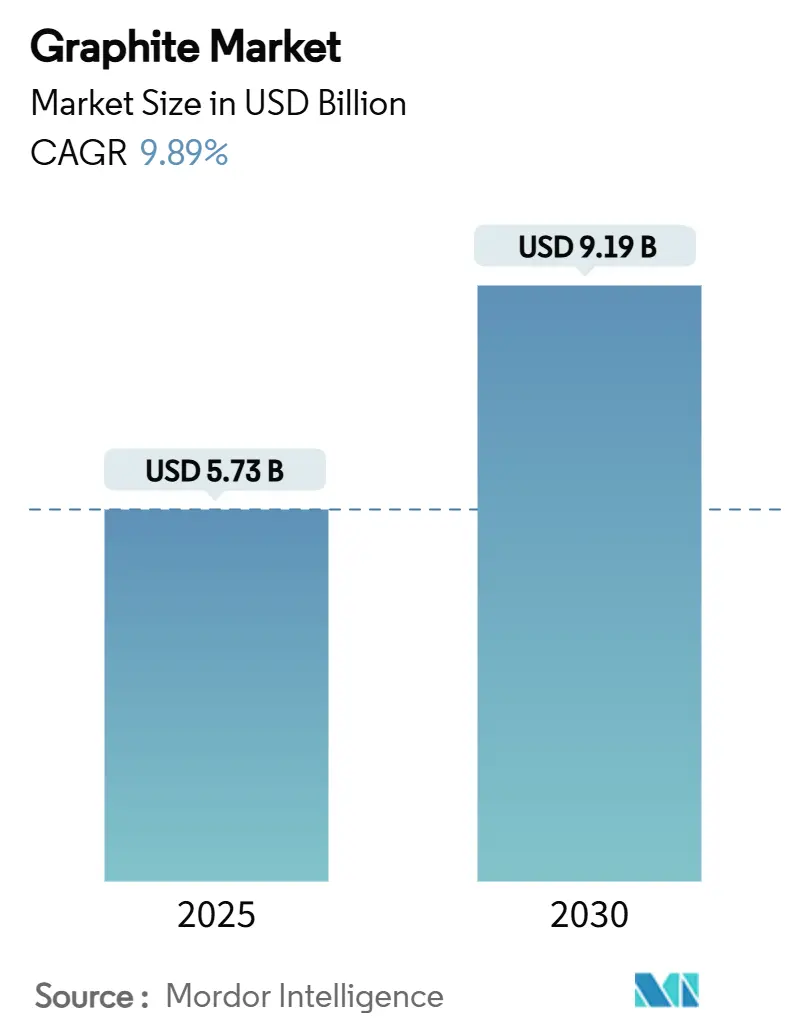
Graphite Market Analysis by Mordor Intelligence
The Graphite Market size is estimated at USD 5.73 billion in 2025, and is expected to reach USD 9.19 billion by 2030, at a CAGR of 9.89% during the forecast period (2025-2030). Robust battery demand, structural shifts in steelmaking, and intensifying efforts to localize critical-material supply chains collectively underpin this trajectory. The graphite industry is experiencing a decisive shift from a bulk commodity sector to a strategic materials arena supporting decarbonization across mobility, power, and heavy industry. Natural-resource concentration in Asia-Pacific and policy incentives in North America and Europe are catalyzing new investment in mining, processing, and recycling assets. Simultaneously, the rising cost of capital and stricter environmental scrutiny are encouraging joint ventures that spread risk while ensuring responsible sourcing. A fresh inference that emerges is that contract structures are lengthening off-take agreements now regularly span 10-plus years, signaling buyers’ willingness to lock in feedstock security even at higher prices.
Key Report Takeaways
- By type, synthetic graphite holds 58.09% market share in 2024, while natural graphite leads growth with a 12.24% CAGR and is steadily eroding synthetic’s dominance.
- By application, batteries lead with a 39.98% market share in 2024; this segment is expanding fastest at a 17.89% CAGR as EV anode demand accelerates.
- By end-user industry, the automotive sector has a 42.91% market share in 2024 and a 16.98% CAGR, confirming its pivotal role in shaping long-term graphite offtake contracts.
- By geography, Asia-Pacific commands a 55.42% market share in 2024 and records the highest regional growth at an 11.24% CAGR.
Global Graphite Market Trends and Insights
Driver Impact Analysis
| Drivers | (~) % Impact on Market CAGR | Geographic Relevance | Impact Timeline |
|---|---|---|---|
| Augmenting Demand from the Lithium-ion Battery Industry | +3.2 | Global, with a concentration in Asia-Pacific and North America | Medium term (~3-4 yrs) |
| Increase in Steel Production in Asia and the Middle East | +1.8 | Asia-Pacific, Middle East | Medium term (~3-4 yrs) |
| Increase in Natural Graphite Recycling Initiatives | +1.5 | North America, Europe | Long term (≥5 yrs) |
| Growing Demand from the Electronics Industry | +1.4 | Asia-Pacific, North America | Medium term (~3-4 yrs) |
| Increasing Demand from the Aerospace and Defense Industry | +0.8 | North America, Europe | Long term (≥5 yrs) |
| Source: Mordor Intelligence | |||
Augmenting Demand from the Lithium-ion Battery Industry
Battery manufacturers now account for the single largest slice of the graphite market share, and the segment’s 17%-plus CAGR indicates sustained acceleration through the decade. Intensifying price competition among electric-vehicle (EV) brands magnifies the cost sensitivity of anodes, tilting preference toward natural graphite that offers a multithousand-dollar per-tonne advantage over synthetic alternatives. This cost gradient is widening as energy prices rise, because synthetic production requires temperatures of 3,000 °C, whereas natural purification usually runs below 1,800 °C. One inference observable from recent tender data is that automakers are accepting slightly lower first-cycle efficiency in exchange for natural graphite’s better ESG profile, illustrating how carbon-footprint metrics have become commercially material.
Increase in Steel Production in Asia and the Middle East
The shift toward electric-arc furnaces (EAF) for emissions abatement is materially lifting demand for ultra-high-power graphite electrodes. Machinery and automotive applications now drive a larger share of steel consumption, implicitly elevating electrode durability and conductivity requirements. A fresh inference is that electrode suppliers can certify lower sulfur and nitrogen contents, secure premium price realizations because EAF operators see a direct link between electrode purity, tap-to-tap time, and overall furnace energy efficiency.
Increase in Natural Graphite Recycling Initiatives
Commercial-scale recycling plants in the United States and Germany demonstrate recovery rates that routinely exceed 80% for graphite embedded in spent batteries. Hydrometallurgical flowsheets recover flake morphology suitable for re-spheronization, effectively converting waste into battery-grade feedstock. Policy instruments such as the European Union’s mandatory recycled-content thresholds for new cells have turned what was once an environmental liability into a revenue stream. A new inference is that recyclers are beginning to pre-contract material with fleets of ride-hailing vehicles, guaranteeing end-of-life battery volumes while offering operators residual-value upside.
Growing Demand from the Electronics Industry
Semiconductor manufacturers rely on isostatically pressed graphite parts for crystal-growth chambers, epitaxial deposition, and ion-implantation fixtures. The miniaturization of circuitry simultaneously shortens process windows and raises temperature uniformity requirements, cementing high-purity graphite’s role in fab tooling. The fresh inference is that chip-plant expansions in the United States and Europe, themselves, are beneficiaries of local manufacturing incentives, quietly creating a geographically diverse, premium-grade graphite submarket decoupled from battery-sector price swings.
Restraint Impact Analysis
| Restraints | (~) % Impact on Market CAGR | Geographic Relevance | Impact Timeline |
|---|---|---|---|
| Stringent Environmental Regulations | -1.2 | Global, with higher impact in Europe and North America | Short term (≤2 yrs) |
| Limited Availability of High-Quality Natural Graphite | -2.1 | Global, with higher impact in regions dependent on imports | Short term (≤2 yrs) |
| Fluctuation in Raw Material Prices | -1.4 | Global | Short term (≤2 yrs) |
| Source: Mordor Intelligence | |||
Stringent Environmental Regulations
Carbon-pricing regimes and Scope-3 disclosure frameworks are prompting producers to adopt renewable power and to pilot low-temperature catalytic graphitization developed by the U.S. Department of Energy, which halves energy use and compresses production cycles from weeks to hours[1]U.S. Department of Energy. “New NETL Catalytic Process Makes High-Quality Graphite from Coal Waste Products.” https://netl.doe.gov.
Limited Availability of High-Quality Natural Graphite
USGS data confirm that China controls roughly three-quarters of the mined supply, with South Korea importing more than 90% of its graphite from Chinese ports in 2022[2]U.S. Geological Survey. “Mineral Commodity Summaries 2024 – Graphite.” https://pubs.usgs.gov. Governments from Seoul to Washington are therefore underwriting exploration and downstream processing to redress this imbalance. Northern Graphite’s acquisition of an idled Ontario mine positions it as the only flake producer in North America, highlighting the scarcity of advanced projects. The fresh inference is that logistics planners now model supply-chain resilience in terms of “shipping days from mine to anode plant,” elevating distance and political-risk metrics to equal footing with grade and cost in procurement algorithms.
Segment Analysis
By Type: Natural Graphite Gains Momentum
Natural graphite is rapidly gaining market share despite synthetic graphite's current dominance at 58.09% of the market in 2024. Fresh purification processes such as caustic baking combined with microwave heating now deliver 99.95% purity, closing the historical performance gap. A clear inference is that life-cycle-assessment data, which now feature in OEM purchasing dashboards, are tipping procurement policies in favor of natural graphite even when immediate cell-level energy density is marginally lower.
Supply-security concerns amplify interest in biomass-derived synthetic graphite, which could reduce dependence on mined natural graphite and petroleum needle-coke routes. Pilot studies confirm that lignin-based precursors yield turbostratic carbon with an interlayer spacing conducive to lithium intercalation. The fresh inference is that dual-sourcing strategies, natural flake plus bio-graphite, are surfacing as an attractive hedge against geopolitical disruption and carbon-price escalation.
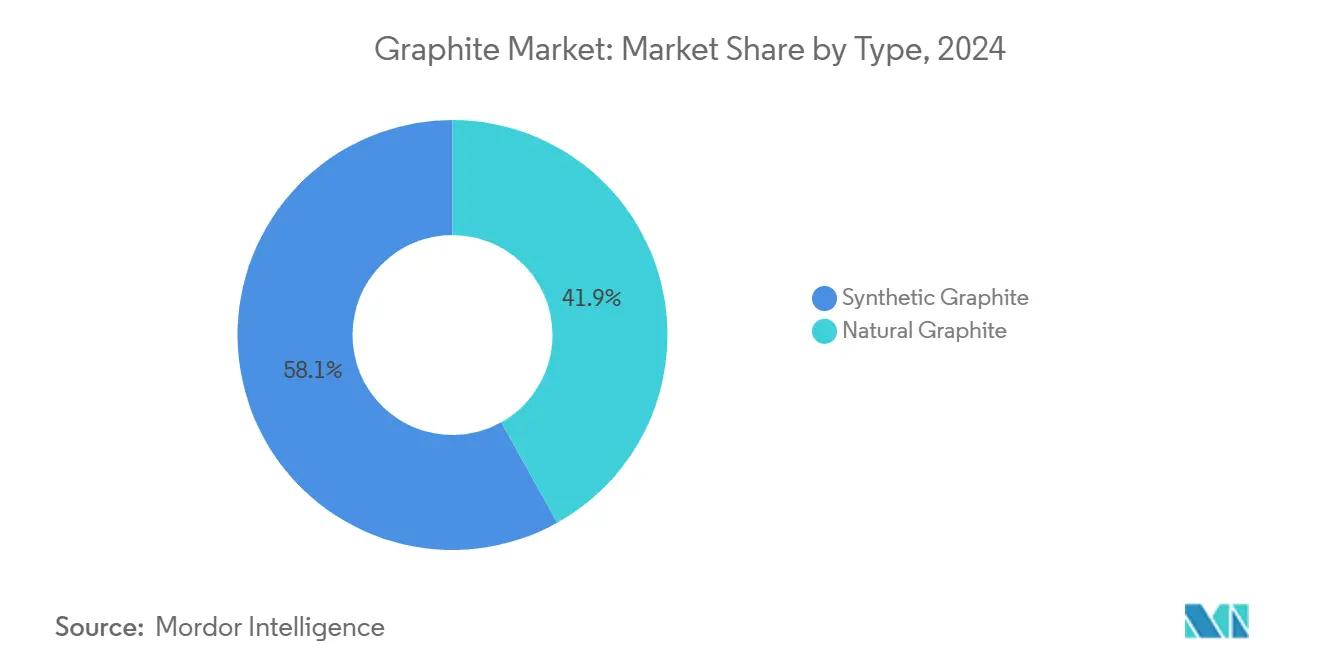
Note: Segment shares of all individual segments available upon report purchase
By Application: Batteries Drive Market Transformation
Battery applications account for the largest graphite market size in 2024 and are projected to grow at nearly 18% CAGR through 2030. Graphite composes up to 99% of a lithium-ion anode, anchoring its centrality in energy-storage cost curves. A pertinent inference is that even incremental silicon-doping of anodes boosts total graphite demand because cell producers still require a graphite scaffold for electronic conductivity and structural integrity.
Electrode demand is tracking the EAF build-out wave, particularly across India and the Gulf, where new scrap-based mini-mills are displacing blast-furnace installations. Refractory applications retain a stable graphite market share because continuous-casting and ladle-furnace operators value the material’s non-wetting characteristics. Emerging uses, such as 3D-printed graphene–polymer heat spreaders, open high-margin niches that monetize graphite’s thermal anisotropy in aerospace de-icing and satellite radiator systems.
By End-user Industry: Automotive Sector Leads Transformation
Automotive producers represent the largest end-user block, underpinning more than 40% of the graphite market share and posting a 16.98% CAGR forecast as battery-electric vehicle penetration rises. Extended-range electric SUVs are shifting cell formats toward higher-energy NMC chemistry, indirectly raising anode graphite intensity per vehicle. A key inference is that fleet operators negotiating battery-as-a-service contracts increasingly request indexed graphite pass-through clauses, transferring raw-material price exposure back to tier-one suppliers.
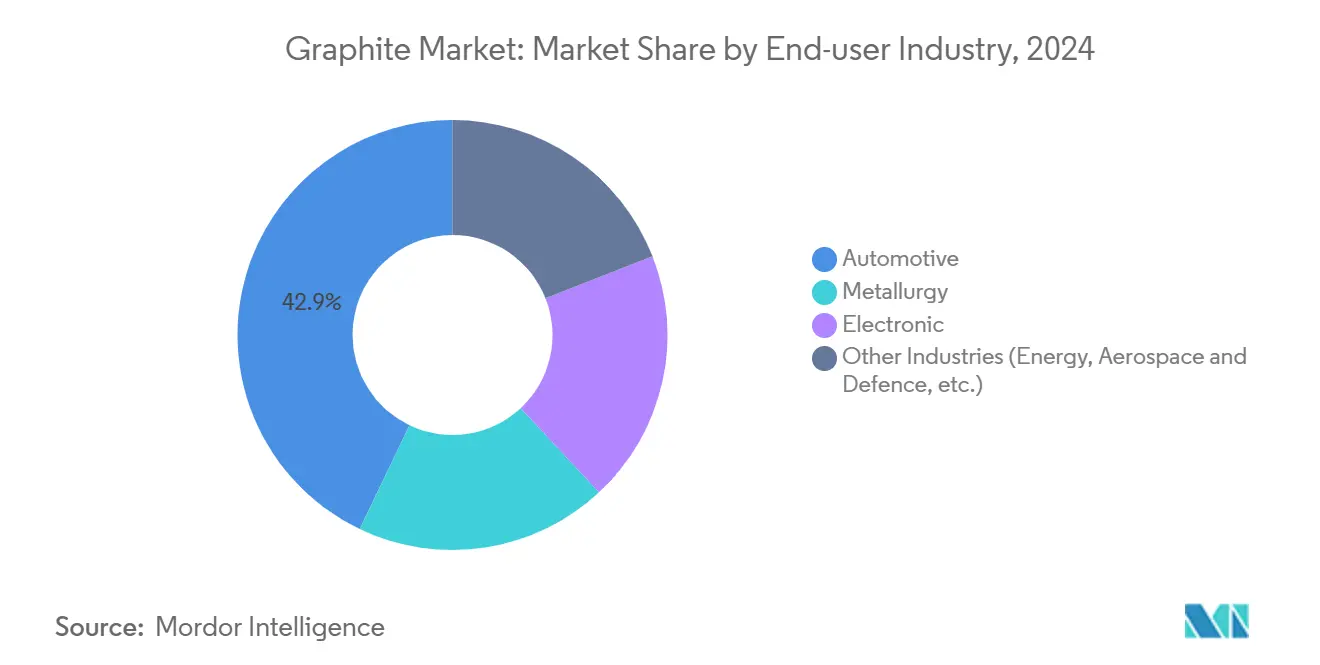
Note: Segment shares of all individual segments available upon report purchase
Geography Analysis
Asia-Pacific currently captures 55.42% graphite market share and registers the fastest regional CAGR at above 11%. China’s dominance stems from integrated clusters that combine flake-graphite mines, purification lines, and spheronization plants into a single logistics corridor. A fresh inference is that ASEAN nations such as Indonesia and Malaysia are courting mid-stream processors, hoping to replicate China’s cluster model and thus create alternative nodes in the value chain.
North America is transitioning from an import-dependent consumer base to an emerging producer, helped by the Inflation Reduction Act’s tax credits that reimburse 10% of qualified anode-component costs. Europe’s graphite industry is shaped by regulatory leadership rather than resource endowment. Mandatory minimum recycled-content thresholds in batteries are pushing gigafactories to sign multi-year supply contracts with recyclers.

Competitive Landscape
The graphite industry remains moderately fragmented, yet competitive moats are deepening around purification technology, vertical integration, and ESG credentials. Chinese producers still dominate mined supply, but Japanese and European firms lead in isostatic pressing and ultra-high-purity segments serving semiconductors and LEDs. Technological leadership is emerging as a critical differentiator. Geopolitics and trade policy are driving new entrants via reshoring incentives and export-control pressures.
Graphite Industry Leaders
-
GrafTech International
-
SGL Carbon
-
Imerys
-
BTR New Material Group Co., Ltd.
-
Shanghai Shanshan Technology Co., Ltd.
- *Disclaimer: Major Players sorted in no particular order
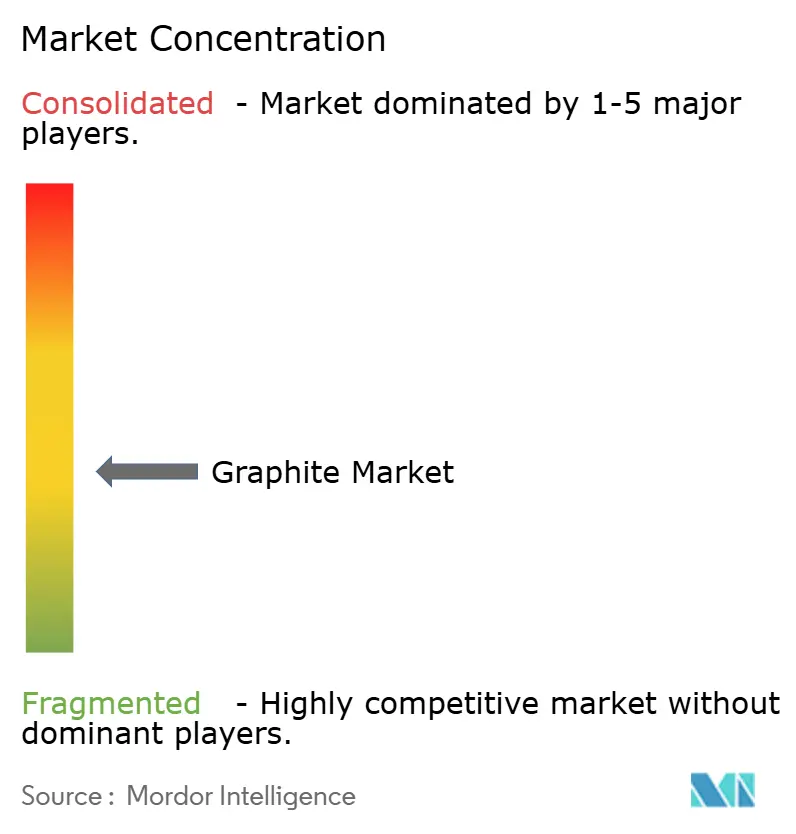
Recent Industry Developments
- April 2025: Imerys introduced SU-NERGY, an industrial-scale graphite solution that cuts CO₂ emissions by up to 60% versus conventional grades. The launch illustrates how process innovation directly improves customers’ Scope 3 emissions disclosure while widening Imerys’ specialty-materials portfolio.
- July 2024: Graphit Kropfmühl partnered with BASF to access renewable-energy certificates for its Hauzenberg plant in Germany. The agreement lowers the site’s graphite carbon footprint by at least 25%, enabling customers to meet EU battery passport requirements ahead of schedule.
Research Methodology Framework and Report Scope
Market Definitions and Key Coverage
Our analysis treats the graphite market as the value generated from natural and synthetic graphite sold in bulk or processed forms for batteries, refractories, electrodes, foundry additives, lubricants, and other industrial uses across all end-user industries in 2025.
Specialty downstream products such as carbon fibers, graphene, and diamond-like carbon coatings are not included, as their supply chains, pricing logic, and demand pools differ materially from bulk graphite.
Segmentation Overview
- By Type
- Natural Graphite
- Synthetic Graphite
- By Application
- Electrodes
- Refractories, Casting and Foundries
- Batteries
- Lubricants
- Other Applications (Thermal Management Materials, Friction Products and Brake Linings,etc.)
- By End-user Industry
- Metallurgy
- Electronic
- Automotive
- Other Industries (Energy, Aerospace and Defence, etc.)
- By Geography
- Asia-Pacific
- China
- India
- Japan
- South Korea
- Rest of Asia-Pacific
- North America
- United States
- Canada
- Mexico
- Europe
- Germany
- United Kingdom
- France
- Italy
- Russia
- Rest of Europe
- South America
- Brazil
- Argentina
- Rest of South America
- Middle-East and Africa
- Saudi Arabia
- South Africa
- Rest of Middle-East and Africa
- Asia-Pacific
Detailed Research Methodology and Data Validation
Primary Research
Mordor analysts interviewed graphite miners, anode material processors, EAF operators, battery cell makers, and regional distributors across Asia-Pacific, North America, and Europe. These conversations clarified purity premia, contract tenure, and end-use splits, filling data gaps and confirming desk-research assumptions before we finalized the model.
Desk Research
We compiled baseline demand and trade clues from tier-one, public sources such as the US Geological Survey (mine output), UN Comtrade (HS 2504, 3801 flows), the World Steel Association (EAF steel tonnage), and the International Energy Agency (EV battery uptake). Company 10-Ks, patent filings retrieved through Questel, and statistics from the China Non-Metallic Minerals Industry Association added context on capacity shifts and technology routes. Subscription databases, including D&B Hoovers for producer revenues and Dow Jones Factiva for price news, helped us cross-check volumes and average selling prices. The above list is illustrative; many additional open datasets were reviewed to validate numbers and trends.
Market-Sizing & Forecasting
We start with a top-down build that reconstructs apparent consumption by aligning mined output, synthetic production, and net trade, followed by sampled ASP × volume checks for electrodes and battery anodes to sense-check totals. Key variables include EV battery gigawatt-hour additions, EAF steel share, needle-coke price shifts, flake-to-spherical conversion yields, and regional capacity additions. A multivariate regression, supplemented by scenario analysis for EV adoption rates, projects these drivers through 2030. Bottom-up supplier roll-ups adjust country-level anomalies.
Data Validation & Update Cycle
Before release, two senior reviewers audit variance flags and triangulate our totals with independent price indices; any outlier triggers re-contact with sources. Reports refresh annually, and interim updates occur when material events, such as export curbs or demand shocks, emerge.
Why Mordor's Graphite Baseline Commands Reliability
Published estimates vary because firms choose different product mixes, purity thresholds, and battery adoption scenarios.
Key gap drivers include some publishers folding graphite electrodes into the wider carbon products universe, others applying aggressive EV penetration or using list prices rather than transaction averages, and refresh cadences differing, leading to currency-conversion drift.
Benchmark comparison
| Market Size | Anonymized source | Primary gap driver |
|---|---|---|
| USD 5.73 B (2025) | Mordor Intelligence | - |
| USD 15.67 B (2024) | Global Consultancy A | Includes carbon fibers, applies list prices |
| USD 20.85 B (2023) | Trade Journal B | Combines graphite with refractory ceramics; older FX rates |
These comparisons show that Mordor's clear scope boundaries, annual refresh, and mixed-method validation deliver a transparent, repeatable baseline that decision-makers can trust.
Key Questions Answered in the Report
What is the expected graphite market size by 2030?
The graphite market is projected to reach about USD 9.18 billion by 2030, supported by battery, steel, and recycling demand.
Why is natural graphite gaining ground over synthetic graphite?
Natural graphite costs less to produce and has a lower carbon footprint, making it attractive for lithium-ion anodes as companies pursue cost savings and sustainability targets.
Which industries consume the most graphite today?
Electric-vehicle batteries lead demand, followed by steel electrodes, refractories, electronics, aerospace, and defense applications.
How do recycling initiatives affect future graphite supply?
New plants can reclaim more than 80 % of graphite from end-of-life batteries, providing a growing secondary supply that reduces dependence on mined material.
What regions dominate the graphite industry?
Asia-Pacific, led by China, holds the largest graphite market share, though North America and Europe are investing heavily in new mining, processing, and recycling facilities to diversify sourcing.
Page last updated on:
